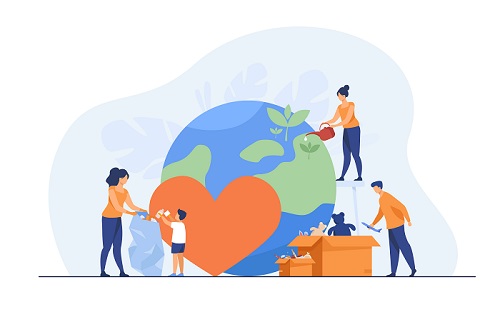When exploring Salesforce for nonprofit organization growth, communication and collaboration often feel like a challenge. From sharing updates with volunteers to providing beneficiaries with self-service access, most nonprofits rely on fragmented tools—emails, PDFs, spreadsheets, or even phone calls.
This leads to lost time, disconnected experiences, and frustrated users.
But what if you could bring it all together in one secure, branded online space?
That’s exactly what Salesforce Experience Cloud offers.
Designed to create personalized, interactive portals and digital communities, Experience Cloud allows nonprofits to give their donors, volunteers, beneficiaries, and partners a secure, self-service hub to connect, learn, and engage.
In this article, we’ll explore how nonprofits can use Experience Cloud to:
- Create donor and volunteer portals
- Empower beneficiaries with service access
- Collaborate with staff and partners
- Deliver personalized digital experiences at scale
Let’s break down what this tool does and how it can serve your mission.
What Is Salesforce Experience Cloud?
Salesforce Experience Cloud (formerly Community Cloud) lets organizations create secure digital experiences for external users — such as donors, volunteers, beneficiaries, and partners.
It allows you to build:
- Portals — for self-service access to forms, documents, event signups, and more
- Websites — for custom campaigns or resource centers
- Communities — for engagement, collaboration, and knowledge sharing
- Mobile-optimized experiences — for anytime, anywhere access
And it all connects to your Salesforce CRM — meaning everything is synced in real time.
Why Nonprofits Should Use Experience Cloud
Here’s why Experience Cloud is a great fit for nonprofits:
- It allows secure access to Salesforce data without giving full system access
- It reduces manual work by enabling self-service
- It creates transparency between your organization and its supporters or service users
- It strengthens relationships by offering value beyond email or social media
- It supports multilingual, mobile-ready, and accessibility-compliant designs
Instead of emailing PDFs or answering repetitive queries, you offer a professional-grade experience — tailored to each user group.
Use Cases of Salesforce Experience Cloud for Nonprofits
Let’s explore how nonprofits are applying Experience Cloud across different audiences.
1. Donor and Fundraiser Portals
Give your donors more than a receipt. Let them:
- View giving history
- Download tax documents
- Update their contact or payment info
- Join campaigns or peer-to-peer fundraisers
- Receive personalized impact reports
You can create tiers of access for major donors, corporate sponsors, or monthly givers.
Want to see how AI enhances nonprofit experiences like this?
Check out: New AI Tools for Nonprofit Cloud
2. Volunteer Portals
Make volunteering easy and organized. Volunteers can:
- Sign up for events and shifts
- Track hours and past participation
- Access training materials or onboarding docs
- Connect with team leads or other volunteers
- Receive recognition badges or thank-you notes
This reduces staff coordination time while improving volunteer satisfaction.
3. Beneficiary Self-Service Access
If your nonprofit provides services (e.g., food assistance, education, counseling), Experience Cloud can help you:
- Create intake forms and service applications
- Show status updates (approved, in progress, completed)
- Upload and download required documents
- Allow two-way communication with case workers
- Offer helpful resources or guides
This boosts transparency and dignity in the service process.
Explore how AI agents assist case management:
4. Community Forums and Peer Support
Sometimes the most valuable resource isn’t a staff member — it’s peer knowledge.
Nonprofits can build communities for:
- Alumni networks
- Youth support groups
- Mentorship programs
- Local chapters or program hubs
- Knowledge sharing among field workers
These communities enable discussions, Q&A, resource sharing, and direct messaging — all within your branded environment.
5. Partner and Grantor Collaboration
For nonprofits working with multiple partners, Experience Cloud simplifies:
- Joint project tracking
- Reporting dashboards
- Budget and document sharing
- Compliance checklists
- Shared calendars and resources
Partners log in securely and only access the data relevant to them.
6. Event Management and Campaign Hubs
Hosting a walkathon or gala? Launching a multi-week campaign?
Create branded microsites or campaign hubs that allow users to:
- Learn about the event
- Sign up or purchase tickets
- Fundraise or donate
- See progress toward goals
- Share updates on social media
Everything is connected to Salesforce, so you can track success in real time.
Key Features That Make Experience Cloud Powerful
Personalized Content
Display different pages, messages, or resources based on the user’s role — donor, volunteer, staff, etc.
Secure Access Control
Use Salesforce’s built-in security model to ensure each user sees only what they’re meant to.
Drag-and-Drop Builder
No need for advanced coding — customize branding, layout, and content blocks easily.
Mobile-Optimized Design
All portals work seamlessly on smartphones and tablets, improving accessibility.
Integrated Analytics
Monitor:
- Logins and session time
- Most accessed content
- Drop-off points in form completions
- Common user paths
- User satisfaction feedback
This allows you to iterate and improve constantly.
Best Practices for Nonprofits Using Experience Cloud
1. Start with One User Group
Begin with your highest-impact group — e.g., major donors, active volunteers, or program beneficiaries. Design the portal around their needs first, then expand.
2. Prioritize Simplicity
Keep navigation clean. Group content logically. Use plain language. Avoid info overload.
3. Brand It Thoughtfully
Use your organization’s colors, tone, and logo. This builds trust and recognition.
4. Gather Feedback
Include forms or pop-ups to ask users how helpful the portal is and what could be improved.
5. Integrate With Email Journeys
Use Marketing Cloud or Engagement Studio to send email reminders based on portal behavior (e.g., “You started your application — want to finish it?”)
Measuring the Impact of Your Portal
After launch, track metrics like:
- Time saved by staff
- Reduction in manual data entry
- Increase in donor retention
- Volunteer engagement rates
- Beneficiary satisfaction scores
- Self-service success (number of tasks completed without staff help)
This turns your portal into a measurable asset, not just a digital brochure.
Example: How One Nonprofit Uses Experience Cloud
A youth development nonprofit built a portal with:
- A mentorship community for youth
- Event registration for volunteers
- Impact dashboards for major donors
- Self-service training access for program alumni
Result:
- Staff reduced email volume by 40%
- Volunteer sign-ups rose 3x
- Donors reported feeling “more connected and informed”
This isn’t a hypothetical — it’s how nonprofits are using technology to deepen relationships and reduce friction.
Conclusion
As a nonprofit, your mission is too important to be slowed down by scattered communication or limited outreach.
With Salesforce Experience Cloud, you can build powerful digital spaces that:
- Engage donors
- Empower beneficiaries
- Activate volunteers
- Collaborate with partners
- Deliver better service
It’s secure, scalable, and customizable — everything a growing nonprofit needs to deliver value 24/7.
Looking to launch your own nonprofit portal?
Let’s make it happen with a trusted Salesforce nonprofit implementation partner. From configuration to user experience design, we’ll guide you at every step.






Comments